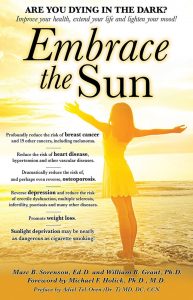Mental illness: Vitamin D deficiency, and thereby sunlight deficiency, plays a major role. By Marc Sorenson, EdD.
Mental illness is a pandemic in the United States. Nearly one in five U.S. adults live with a mental illness (46.6 million in 2017). Mental illness has multiple causes and manifestations. It is especially relevant to understand that sunlight deprivation, leading to vitamin D deficiency, plays a major role in this disorder. It is also important to realize that sun exposure, for typical people, produces about 90% of serum (blood) vitamin D. In addition, this production occurs when midday sunlight touches the skin. However, vitamin D is only one of several photoproducts produced by sun exposure to skin or other body parts. In addition, sun exposure produces serotonin, endorphin, dopamine, and brain-derived neurotropic factor (BDNF). Furthermore, all of these vital chemicals has a profound influence on mental Illness.
An important study on vitamin D
The disease is ubiquitous, as is sun deprivation. Thus, thus an investigation on vitamin D and mental illness reminded me of the affects of sunlight. This laboratory-based study found a high prevalence of vitamin D deficiency among 290 patients with mental illness. Consequently, Only 18% of these patients showed adequate levels of vitamin D. To me, this also means that only 18% were obtaining sufficient sun exposure for good mental health and well-being. The researchers concluded that sensible sun exposure could be a boon to mental health.
Let us now discuss a few of the disorders classified as types of mental illness. Then we will also mention the research that indicates an impressive salutary influence of sun exposure.
ADHD, a mental illness of children
ADHD ( attention deficit hyperactivity disorder) is the most prevalent of all mental disorders in children. Hence, it causes significant problems with executive functions, leading to hyperactivity or impulsiveness not appropriate for the person’s age.
Researchers have found that sun exposure correlates to a decreased risk of ADHD. They assessed the relationship between the prevalence of ADHD and the intensity of the sun in various nations and in US states. And after adjusting for birth weights, infant mortality and other relevant factors, the findings were not altered. It was obvious that sun deprivation by itself was associated with a higher risk of ADHD.
Autism, another disease of youth
Is autism a sun-deficiency disorder? Autism rates are increasing exponentially and associate to vitamin D deficiency, which, of course, associates to sun deficiency. The Autism Society of America defines autism as “a complex developmental disability typically appearing during the first three years of life and is the result of a neurological disorder affecting the normal functioning of the brain, impacting development in the areas of social interaction and communication skills. Both children and adults with autism typically show difficulties in verbal and non-verbal communication, social interactions, and leisure or play activities.”
If vitamin D deficiency and/or sun deprivation relates to autism, symptoms should improve in summer. Thus, a case study reported by Dr. Cannell revealed improvements in autism-related sleep and behavioral problems during summer. Autistic traits such as crying, excitability, hyperactivity and pounding objects profoundly diminished during summer.
Bipolar Disorder
Bipolar disorder (BPD), also known as manic-depressive illness, is a brain disorder causing unusual shifts in mood, energy, activity levels, and the ability to perform day-to-day tasks. Symptoms are severe and can result in damaged relationships, poor job or school performance and even suicide.https://www.nimh.nih.gov/health/topics/bipolar-disorder/index.shtm
Sun exposure resets the body’s circadian rhythms, which are variations in physiology and behavior persistent with a cycle length close to 24 hours. This system is contained in the hypothalamus and stimulated by nerve cells in the retina of the eye in response to light. Research indicates that environmental conditions early in life may imprint the circadian system and influence mental function later in life: Increased number of hours of daylight at the location of birth during the first three months of life are associated with a significantly older age of onset of bipolar disorder. For a longer discussion on bipolar disorder, read the book, Embrace the Sun.
Cognitive disabilities (intellectual disorders)
Another research study, based on a 15-year residential history of varying degrees of sun exposure, produced an interesting result. It showed that cognitive impairment in persons who were below the median exposure to sunlight was 88% greater than in those who were above the median. These same investigators had previously shown that lower levels of sun exposure resulted in a 2.6-times higher incidence of cognitive impairment. Therefore, if you want to think clearly and keep your marbles, regularly soak up some non-burning sunlight.
Depression
Few people realize how prevalent depression is in our society, a mental illness representing a huge drain on the economy. Moreover, according to Steven Genuis, in an editorial in Canadian Family Physician, “The World Health Organization estimates depression costs the American economy about $44 billion annually, equal to the total cost of all cardiovascular diseases.” He also stated that in one decade, there was a 300% increase in the sales of antidepressants, making these medications the top-selling pharmaceuticals in the world. (Genuis, S. Keeping your sunny side up (editorial). Canadian Family Physician 2006:52:42-43.)
So what does the sun do to relieve “the blues?”
The answer probably lies in a chemical responsible for transmitting impulses between nerve cells. This “neurotransmitter,” serotonin, is a natural “upper,” and works in synchronization with the natural “downer,” melatonin. When we awake to sunshine, light enters the eye and stimulates serotonin production. We then quickly become awake and invigorated, and melatonin diminishes. Nevertheless, at day’s end, the bright light disappears (or at least it should), melatonin levels rise, and serotonin levels diminish. We begin to feel sleepy and ideally retire for a good night’s rest. It is a perfect system for our needs—unless we stay up beyond biologically natural hours, by using artificial lighting. Many experts believe that lack of serotonin is a cause of depression.
The most important study on serotonin
Though I mentioned this study in my previous blog on sunlight and depression, it bears repeating here. Dr. Gavin Lambert performed one of the most important and unique studies on serotonin. He and his colleagues measured serotonin levels in response to varying degrees of sunlight. First of all, they drew blood samples from the internal jugular veins of 101 men. In addition, they compared the serotonin concentrations of the blood to weather conditions and seasons. As a result, men measured on a bright day produced eight times more serotonin, than those measured on a dismal day. Of course, the mood improved due to sunlight, with no involvement whatsoever of vitamin D. Thus, regular, non-burning sun exposure is the answer to depression. In addition, remember that sun exposure also leads to the production of other mood enhancers such as nitric oxide, endorphin and dopamine.
Certainly, sunlight deprivation is not the only cause of mental illness, but it is one of the most important.
There are more mental illnesses to discuss, and I will expatiate on those in a future article. In the meantime, protect your mental health by being sure to obtain your share of non-burning sunlight. For more information, visit sunlightinstitute.org, and read the book, Embrace the Sun.
By Marc Sorenson, EdD, for sun exposure and children’s health…
It is well-known that sun exposure is associated with a reduced risk of many major cancers in adults. But what about children? A California study has shown that sun exposure during pregnancies also influences the childhood cancer risk of children who are a result of those pregnancies.[1] In this research, sun exposure, based on the geographical area where the women lived while pregnant, was measured. Then their children were compared in terms of childhood cancer risk, based on high or low sun exposure. Those children whose mothers experienced more sun exposure were less likely to develop acute lymphoblastic leukemia, hepatoblastoma, and non-hodgkin’s lymphoma. The authors of the study make this summary statement: “Our findings suggest that UVR during pregnancy may decrease the odds of some childhood cancers. Future studies should explore additional factors that may be correlated with UVR exposure and possibly include biomarkers of immune function and vitamin D.”
We have discussed in previous blogs the association of sunlight deficiency during women’s pregnancies and the subsequent risk of profoundly increased autism in their children. Therefore, similar results with cancer are not surprising. Safe, non-burning sun exposure has positive effects on at least 100 of the most frightening diseases, many of which will be discussed in my upcoming book that is coauthored by Dr. William B. Grant, and entitled Embrace the Sun. Children, even babies, need at least some sun exposure. And children, if they do not get outdoors in the sun are also subject to a remarkable increase in the risk of myopia.[2]
Take care of your children. Be sure that they play in the sunlight each day, without sunscreen. If any reddening occurs, put them in the shade or cover them up. But don’t deny them their share of sunshine; if you do, their risk of childhood cancers may increase.
[1] Lombardi C, Heck JE, Cockburn M, Ritz B. Solar UV radiation and cancer in young children. Cancer Epidemiol Biomarkers Prev. 2013 Jun;22(6):1118-28.
[2] Rose KA, Morgan IG, J, Kifley A, Huynh S, Smith W, Mitchell P. Outdoor activity reduces the prevalence of myopia in children. Ophthalmology 2008 Aug;115(8):1279-85.
By Marc Sorenson, EdD, Sunlight Institute
Babies and their mothers need Sunlight! Research published in October, 2015[i] is supremely important and establishes two important facts:
- Children born in summer are more likely to be healthy when they become adults.
- When women get more sunlight during pregnancy, it leads to a higher birth weight for their babies, and later puberty for girls.
Girls born in the months of June, July and August, according to the research, have a higher birthweight and later puberty, which have profound, positive impacts on overall health in women as adults. And girls born in the sunny months are also taller as adults. Later puberty is associated with a lesser risk of breast cancer,[ii] and it is likely that other health problems are associated with early puberty, which is also closely related to the type of food consumed. Soda pop consumption, for example, is associated with early puberty.[iii] Low birthweight babies also have problems such as increased risk of autism, lower cognitive function and increased risk attention-deficit hyperactivity.[iv]
Anything that can reduce the risk of these disorders should be considered critical to the health of the baby and essential to the progression to adulthood. Sunlight exposure for both the pregnant mother and her newborn should be the sine qua non for child’s wellbeing. Coupled with a decent nutrition program, sans soda pop and junk foods, it can assist the child to a healthful and productive life.
[i] http://www.eurekalert.org/pub_releases/2015-10/e-cbi100715.php Accessed October 13, 2015
[ii] Ambrosone CB, Zirpoli G, Hong CC, Yao S, Troester MA, Bandera EV, Schedin P, Bethea TN, Borges V, Park SY, Chandra D, Rosenberg L, Kolonel LN, Olshan AF, Palmer JR. Important Role of Menarche in Development of Estrogen Receptor-Negative Breast Cancer in African American Women. J Natl Cancer Inst. 2015 Jun 17;107(9).
[iii] Carwile JL, Willett WC, Spiegelman D, Hertzmark E, Rich-Edwards J, Frazier AL, Michels KB. Sugar-sweetened beverage consumption and age at menarche in a prospective study of US girls. Hum Reprod 2015 Mar;30(3):675-83.
[iv] Ochiai M, Ichiyama M, Iwayama M, Sakai Y, Yoshida K, Hara T. Longitudinal study of very low birth weight infants until 9years of age; attention deficit hyperactivity and autistic features are correlated with their cognitive functions. Early Hum Dev. 2015 Oct 3. [Epub ahead of print].
By Marc Sorenson, EdD Sunlight Institute
We have previously discussed information indicating that people who received more sunlight had better brain function, and noted the relationship between Alzheimer’s, autism and other mental disorders and lack of sun. A recent study compared cognitive impairment and sunlight in a 15-year residential history of varying degrees of sunlight exposure. It showed that cognitive impairment in persons who were below the median exposure to sunlight was 88% greater than those who were above the median.[1]
The researchers mentioned vitamin D as a possible mechanism by which sunlight positively influenced cognition, but also remarked that regulation of the circadian rhythm by sunlight could be a factor. These same investigators had previously shown that lower levels of sunlight exposure resulted in a 2.58-times higher incidence of cognitive impairment.[2]
So, if you would like to maintain your cognitive abilities, soak up a little non-burning sunlight!
[1] Kent ST, Kabagambe EK, Wadley VG, Howard VJ, Crosson WL, Al-Hamdan MZ, Judd SE, Peace F, McClure LA. The relationship between long-term sunlight radiation and cognitive decline in the REGARDS cohort study. Int J Biometeorol. 2014 Apr;58(3):361-70.
[2] Kent ST, McClure LA, Crosson WL, Arnett DK, Wadley VG, Sathiakumar N. Effect of sunlight exposure on cognitive function among depressed and non-depressed participants: a REGARDS cross-sectional study. Environ Health. 2009 Jul 28;8:34







